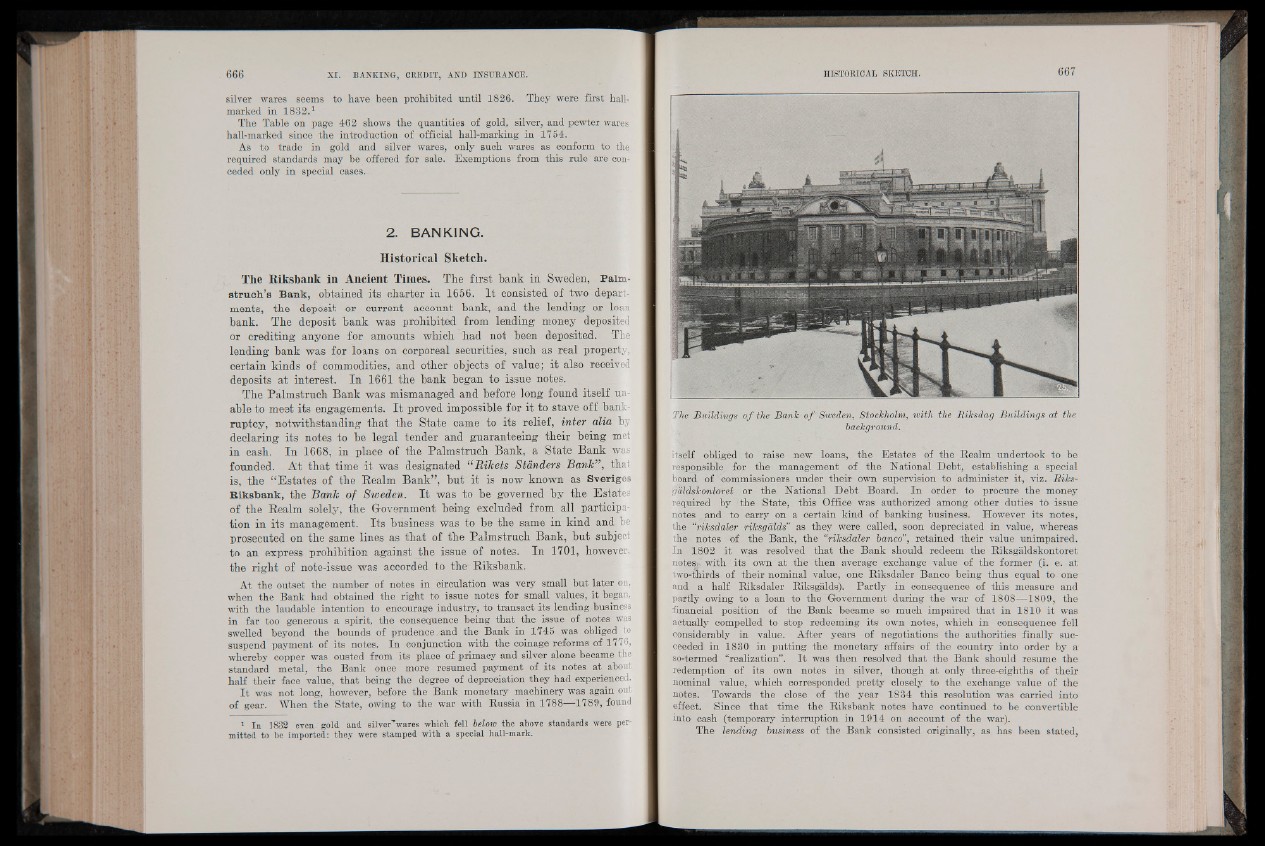
silver wares seems to have been prohibited until 1826. They were first hallmarked
in 18 3 2 .1
The Table on page 462 shows the quantities of gold, silver, and pewter wares
hall-marked since the introduction of official hall-marking in 1764.
As to trade in gold and silver wares, only such wares as conform to the
required standards may be offered for sale. Exemptions from this rule are conceded
only in special cases.-
2. BANKING.
Historical Sketch.
The Riksbank in Ancient Times. The first hank in Sweden, Palm-
struch’s Bank, obtained its charter in 1656. It consisted of two departments,
the deposit or current account bank, and the lending or loan
bank. The deposit bank was prohibited from lending money deposited
or crediting anyone for amounts which had not been deposited. The
lending bank was for loans on corporeal securities, such as real property,
certain kinds of commodities, and other objects of value; it also received
deposits at interest. In 1661 the bank began to issue notes.
The Palmstruch Bank was mismanaged and before long found itself unable
to meet its engagements. It proved impossible for it to stave off bankruptcy,
notwithstanding that the State came to its relief, inter alia by
declaring its notes to be legal tender and guaranteeing their being met
in cash. In 1668, in place of the Palmstruch Bank, a State Bank was
founded. At that time it was designated “ Rikets Ständers Bank”, that
is, the “Estates of the Realm Bank”, but it is now known as Sv eriges
Biksbank, the Bank of Sweden. It was to be governed by the Estates
of the Realm solely, the Government being excluded from all participation
in its management. Its business was to be the same in kind and be
prosecuted on the same lines as that of the Palmstruch Bank, but subject
to an express prohibition against the issue of notes. In 1701, however,
the right of note-issue was accorded to the Riksbank.
At the outset the number of notes in circulation was very small but later on,
when the Bank had obtained the right to issue notes for small values, it began,
with the laudable intention to encourage industry, to transact its lending business
in far too generous a spirit, the consequence being that the issue of notes^was
swelled beyond the bounds of prudence,and the Bank in 1745 was obliged, to
suspend payment of its notes. In conjunction with the coinage reforms of 1776,
whereby copper was ousted from its place of primacy and silver alone became the
standard metal, the Bank once more resumed payment of its notes at about
half their face value, that being the degree of depreciation they had experienced.
I t was not long, however, before the Bank monetary machinery was again out
of gear. When the State, owing to the war with Russia in 1788— 1789, found
1 In 1832 even gold and silver’ wares which fell below the above standards were permitted
to be imported: they were stamped with a special hall-mark.
The Buildings o f the Bank o f Sweden, Stockholm, with the Riksdag Buildings at th
background.
itself obliged to raise new loans, the Estates of the Realm undertook to be
responsible, for the management of the National Debt, establishing a special
board of commissioners under their own supervision to administer it, viz. Riks-
galdskontoret or the National Debt Board. In order to procure the money
required by 'the State, this Office was authorized among other duties to issue
notes and to carry on a certain kind of banking business. However its notes,
the “riksdaler riksgalds" as they were_ called, soon depreciated in value, whereas
the notes of the Bank, the “riTcsdaler banco”, retained their value unimpaired.
In 1802 it was resolved that the Bank should redeem the Riksgaldskontoret
notes* with its own at the then average exchange value of the former (i. e. at
two-thirds, of their nominal value, one Riksdaler Banco being thus equal to one
and a half Riksdaler Riksgalds). Partly in consequence of this measure and
partly owing to a loan to the Government during the war of 1808— 1809, the
financial position of the Bank became so much impaired that in 1810 it was
actually Compelled to stop redeeming its own notes, which in consequence fell
considerably in value. After years of negotiations the authorities finally succeeded
in 1830 in putting the monetary affairs of the country into order by a
so-termed “realization”. It was then resolved that the Bank should resume the
redemption of its own notes in silver, though at only three-eighths of their
nominal value, which corresponded pretty closely to the exchange value of the
notes. Towards the close of the year 1834 this resolution was carried into
effect. SinCe that time the Riksbank notes have continued to be convertible
into cash (temporary interruption in 1914 on account of the war).
The lending business of the Bank consisted originally, as has been stated,